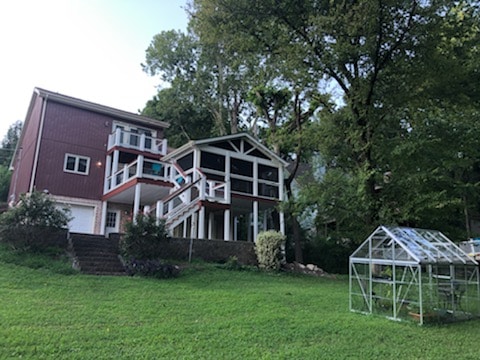How to Choose the Right Materials for Your Outdoor Deck

Deck Building Materials
Building an outdoor deck can dramatically improve your home’s outdoor living space, providing a comfortable area for relaxing, entertaining, and enjoying the natural environment. However, the key to a durable and beautiful deck lies in choosing the right materials. At American Services of TN, we understand that selecting the best materials for your deck is essential for its longevity and overall performance. Here are some tips on how to choose the right materials for your outdoor deck.
Factors to Consider When Selecting Decking Materials
1. Consider the Climate
When choosing decking materials, the climate in your area is one of the most critical factors to consider. Different materials react differently to various weather conditions such as rain, sun, snow, and humidity. For instance, if you live in a region with a lot of rainfall or high humidity, naturally moisture-resistant woods like cedar and redwood are excellent choices because they are less prone to rot and decay. These woods also contain natural oils that help prevent insect infestations. On the other hand, if you reside in an area with intense sun exposure, composite decking might be more suitable due to its resistance to fading and heat retention, ensuring your deck stays cool underfoot and maintains its color longer.
Example: In a coastal area with salty air and high humidity, you might choose a durable hardwood like ipe, which is resistant to both moisture and salt, or a high-quality composite that won’t warp or rot in damp conditions.
2. Think About Maintenance
Maintenance requirements are another crucial aspect to consider when selecting decking materials. Traditional wood decking is known for its natural beauty, but it comes with the responsibility of regular upkeep. To keep a wooden deck looking its best, you’ll need to sand, stain, and seal it periodically to protect it from the elements and prevent wear and tear. For those who prefer a more hands-off approach, composite decking offers a low-maintenance alternative. Unlike wood, composite materials do not need to be sanded, stained, or sealed. A simple cleaning with soap and water is typically sufficient to keep them looking fresh. This makes composite decking an attractive option for homeowners who want to enjoy their outdoor space without the added time and effort of frequent maintenance.
Example: If you have a busy lifestyle and want to minimize upkeep, composite decking, which only requires occasional washing, could save you significant time and effort compared to wood decking.
3. Evaluate Durability and Longevity
The durability and longevity of decking materials are paramount, as a deck is a long-term investment that should withstand the test of time. Hardwoods like ipe and teak are renowned for their exceptional durability, with the potential to last several decades when properly maintained. These woods are naturally resistant to rot, decay, and insects, making them ideal for outdoor use. However, they also come at a higher price point. Composite materials, while sometimes less authentic in appearance, offer impressive durability and are resistant to common issues like rot, pests, and mold. They are also less prone to warping and splintering than wood, making them a safe and long-lasting option for high-traffic areas.
Example: If you plan to use your deck frequently for entertaining, you might choose a material like ipe for its strength and longevity, or a high-quality composite for its durability and minimal maintenance needs.
4. Consider Aesthetics and Design
Aesthetics and design are also important factors when selecting decking materials, as your deck should enhance the overall look and feel of your home. Wood decking provides a classic, timeless appeal with its rich, natural grains and warm tones, making it a popular choice for traditional and rustic home designs. However, wood’s appearance can change over time, requiring maintenance to preserve its original beauty. Composite decking, on the other hand, is available in a wide range of colors and textures, some of which closely mimic the appearance of real wood. This allows you to achieve a consistent and customized look that complements your home’s architecture and landscape design.
Example: For a modern home, you might opt for composite decking in a sleek, uniform color that complements the minimalist design, whereas for a rustic cottage, natural wood decking could provide the perfect, authentic touch.
5. Compare Costs
Cost is always a significant consideration in any home improvement project. While premium hardwoods and high-end composites tend to have a higher upfront cost, their durability, low maintenance, and longevity can make them more cost-effective in the long run. Pressure-treated wood, while less expensive initially, may require more frequent maintenance, repairs, and eventual replacement, potentially leading to higher overall costs over time. When evaluating the cost, it’s important to consider both the initial investment and the long-term expenses associated with maintenance, repairs, and replacements.
Example: If you’re on a tight budget but want a long-lasting solution, investing in a mid-range composite might be more economical over time compared to the ongoing costs of maintaining a pressure-treated wood deck.
6. Assess Environmental Impact
For those who are environmentally conscious, the sustainability of decking materials is an important factor to consider. Wood is a natural and renewable resource, especially when sourced from responsibly managed forests that practice sustainable harvesting. Certified woods such as those with FSC (Forest Stewardship Council) certification ensure that the material comes from environmentally responsible and socially beneficial practices. Composite decking, while made from a blend of wood fibers and plastics, often incorporates recycled materials, reducing the need for virgin resources and diverting waste from landfills. However, the production process and eventual disposal of composite materials should also be considered when evaluating their environmental impact.
Example: If sustainability is a priority, you might choose decking made from reclaimed wood or a composite material with a high percentage of recycled content.
Deck Building Materials Conclusion
Choosing the right materials for your outdoor deck involves balancing factors like climate compatibility, maintenance needs, durability, aesthetic preferences, cost, and environmental impact. At American Services of TN, we are here to help you navigate these choices, ensuring that you select the best materials for your specific needs and lifestyle.
Ready to build your dream deck? Fill out our form below to get in touch with us at American Services of TN. Let’s create a beautiful and lasting outdoor space together!



